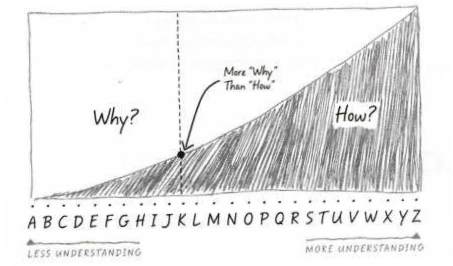De kunst van het uitleggen – The Art of Explanation
Waarom is het zo moeilijk om iets goed uit te leggen, juist over een onderwerp waar je zelf veel vanaf weet? Wat is er nodig om uitleg te geven die wel werkt? Het boek The Art of Explanation zet het op een rij.
Al een tijdje heb ik het idee dat het onderscheid tussen overtuigende en informatieve teksten kunstmatig is. Een wervende tekst moet ook informeren, een informatieve tekst ook overtuigen, al is het maar om verder te lezen. Met The art of explanation viel alles op zijn plaats: daarin wordt uitleggen gedefinieerd als feiten zo beschrijven dat ze mensen iets kunnen schelen. En dan komen informeren en overtuigen dicht bij elkaar.
Lee Lefeber is oprichter van Common Craft, een bedrijf dat video’s maakt met uitleg over bijvoorbeeld over lastige begrippen zoals wiki’s en zakelijk twitteren. In het pas verschenen The art of explanation houdt hij een warm pleidooi voor uitleggen als een vaardigheid.

Now more than ever, I am a believer in the power of explanation, and not just for product and service videos. I believe it is a skill that everyone can learn and improve upon, and one that is needed to help people grasp ideas in a useful and productive way.
Lefeber bespreekt eerst een paar redenen waarom het zo moeilijk is om goede uitleg te geven: gebrek aan inlevingsvermogen in de lezer, verkeerde aannames maken door de curse of knowledge, slim willen overkomen door te ingewikkelde verhalen. Toch is het de moeite waard om toch moeite te doen oem iets goed uit te leggen. Want datzorgt voor betrokkenheid:
Explanations have a different goal: to present an idea in a way that makes people care. Explanations grab their attention and let them see an idea from a personal perspective so they can make informed decisions about learning more. And that is the key point: explanations are packages of ideas that help people feel confident in choosing to learn more because they care about the idea.
Dan introduceert Lefeber de explanation scale waarop je het begrip van je publiek kunt weergeven:

Deze schaal laat zien waar het vaak misgaat: uitleg begint met het hoe te beschrijven, terwijl het publiek nog niet overtuigd is dat ze er meer van willen weten. De reactie is dan: ‘nou en?’. Denk dus eerst na over de voorkennis van degenen die je wil bereiken.
Als je weet wat je publiek begrijpt kun je dat begrip met uitleg gaan vergroten. Hierbij is simplificatie belangrijk, want details en uitzonderingen zijn ruis , drempels voor begrip: ‘Trade accuracy for understanding’. En dit zijn de elementen om een goede uitleg mee op te bouwen:
- overeenstemming: begin met uitspraken die je publiek kan onderschrijven
- context: vertel je publiek iets over de achtergrond van het begrip dat je gaat uitleggen
- verhaal : betrek ervaringen van mensen bij feiten, kies een persoonlijk perspectief (niet altijd toepasbaar)
- verbindingen: vergelijk iets nieuws met iets bekends en maak het zo begrijpelijk
- beschrijvingen: tot nu toe ging het om het waarom, nu kun je je concentreren op het hoe
- conclusie
Voorbeeld
In de transcriptie van de video Search Engine Optimization (SEO) Explained by Common Craft zijn de meeste elementen te zien.
[contekst/verbinding]
Imagine for a minute that you’re a librarian, but not a normal one. You’re a librarian for every book in the world. People depend on you every day to find the exact book they need. How do you do it?[overeenstemming]
You need a system. You need to know what’s inside every book and how books relate to each other. Your system needs to take in a lot information and spit out the best answers for a patron’s questions. It’s not an easy job.[contekst/verbinding]
Search engines like Google and Bing are the librarians of the Internet. Their systems collect information about every page on the web so they can help people find exactly what they are looking for. And every search engine has a secret recipe, called an algorithm – for turning all that information into useful search results.[beschrijving]
Now, if you own a website, search results matter. When your pages have higher rankings, they help more people find you. The key to higher rankings is making sure your website has the ingredients search engines need for their recipes. This is called search engine optimization or SEO.As it turns out, most of the big ingredients are known. Let’s take a look…
First, words matter. Search engines account for every word on the web. This way, when someone searches for “shoe repair” the search engines can narrow the results to only the pages that are about those words.
Second, titles matter. Each page on the web has an official title, but you may not ever see it because it’s in the code. Search engines pay a lot of attention to page titles because they often summarize the page, like a book’s title.
Third, links between websites matter. When one web page links to another, it’s usually a recommendation, telling readers “this site has good information”. A web page with a lot of links coming to it can look good to search engines. But some people try to fool the search engines by creating or buying bogus links all over the web that point to their own website. Usually search engines can detect when a site has a lot of them. And they account for it by giving links from trustworthy sites more weight in the recipe.
Fourth, the words that are used in links matter too. If your webpage says “Amazon has lots of books” and the word “books” is linked, search engines can establish that amazon.comis related to the word “books”. This way when someone searches for books, that site will rank well.
Lastly, search engines care about reputation. Sites with a consistent record of fresh engaging content and growing numbers of quality links may be considered rising stars and do well in search rankings.
[conclusie]
These are just the basics and the recipes are refined and changed all the time. Good SEO is about making sure your website has great content that supported by the ingredients that search engines need for their recipes.
In dit voorbeeld is geen echt verhaalelement, dat is er wel in de video over wiki’s.
Het boek geeft veel meer voorbeelden en informatie, ook over het presenteren van je uitleg. Hoe kies je het juiste medium (niet verrassend is Lefeber een voorstander van video’s), hoe maakt je je verhaal opmerkelijk? Hoe gebruik je beelden? En natuurlijk veel illustraties en links naar video’s.
The Art of Explanation belicht uitleggen, het begrijpelijk overbrengen van informatie van een breder perspectief dan alleen taal en simplificatie (zoals de voorstanders van het taalniveau B1). Een aanrader! Meer over het boek op artofexplanation.com en explainthatidea.com.

Geef een reactie